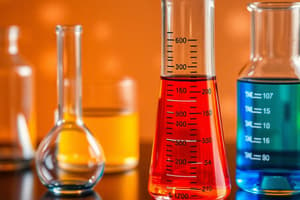Podcast
Questions and Answers
What is the unit of molarity?
What is the unit of molarity?
- mol L^–1 (correct)
- M (molar)
- mol kg^–1
- g/mol
How is molality defined?
How is molality defined?
- Number of moles of solvent per 1000 g or 1 kg of solute
- Number of moles of solute per 1000 g or 1 kg of solvent (correct)
- Number of moles of solute per mole of solvent
- Number of moles of solute per litre of solution
Which property does not change with temperature according to the text?
Which property does not change with temperature according to the text?
- Mole fraction (correct)
- Molality
- Normality
- Mass percentage
What is the unit of molality?
What is the unit of molality?
How is mass percentage calculated?
How is mass percentage calculated?
What is the formula for calculating mass percentage of a solute in a solution?
What is the formula for calculating mass percentage of a solute in a solution?
Which percentage is commonly used in medicine and pharmacy?
Which percentage is commonly used in medicine and pharmacy?
How is parts per million (ppm) defined?
How is parts per million (ppm) defined?
Which type of ppm expresses the concentration by relating the mass of a component to the total mass of the solution?
Which type of ppm expresses the concentration by relating the mass of a component to the total mass of the solution?
What is the formula for calculating mole fraction?
What is the formula for calculating mole fraction?
What does the sum of mole fractions of all components in a solution always add up to?
What does the sum of mole fractions of all components in a solution always add up to?
What is the formula for calculating mole fraction of a component?
What is the formula for calculating mole fraction of a component?
Which formula is used to calculate Molarity (M)?
Which formula is used to calculate Molarity (M)?
What does Normality (N) represent in a solution?
What does Normality (N) represent in a solution?
How is Mass Percentage calculated in a solution?
How is Mass Percentage calculated in a solution?
What is the relationship between Molarity (M) and Molality (m)?
What is the relationship between Molarity (M) and Molality (m)?
How is Molality (m) related to Mole fraction of solute (χB)?
How is Molality (m) related to Mole fraction of solute (χB)?
Flashcards are hidden until you start studying
Study Notes
Concentration of Solutions
- W% (Mass percentage) is defined as the mass of solute in the solution per 100 g of the solution.
- W% = (Mass of solute in the solution × 100) / Total mass of the solution
Volume Percentage
- V% (Volume percentage) is defined as the volume of solute dissolved per 100 mL of solution.
- V% = (Volume of solute × 100) / Total volume of the solution
Mass by Volume Percentage
- w% (Mass by volume percentage) is defined as the mass of solute dissolved per 100 mL of solution.
- w% = (Mass of solute × 100) / Volume of solution
Parts Per Million (ppm)
- ppm is defined as the parts of a component per million (10^6) parts of the solution.
- ppm can be expressed in three ways: mass to mass, volume to volume, and mass to volume.
Mole Fraction
- Mole fraction is the ratio of the number of moles of a particular component to the total number of moles of all the components.
- χA = nA / (nA + nB), where nA is the number of moles of component A and nB is the number of moles of component B.
Key Formulae
- Mole fraction of a component = x1 = n1 / (n1 + n2)
- Molarity (M) = Number of moles of solute / Volume of solution in Litre
- Molality (m) = Number of moles of solute / Mass of solvent in kg
- Normality (N) = Number of gram equivalents of solute / Volume of solution in Litre
Relationships between Concentration Terms
- Relationship between Molarity (M) and Molality (m): dM / (1 - B) = M / 1000m
- Relationship between Mole fraction of solute (χB) and Molality (m): m = χB × 1000 / (1 - χB) × MA
Molarity and Molality
-
Molarity (M) is defined as the number of moles of solute per litre of solution.
-
M = WB × 1000 / MB × V
-
Unit of Molarity is mol L^-1 or M (molar).
-
Molality (m) is defined as the number of moles of solute per 1000 g or 1 kg of solvent.
-
m = WB × 1000 / MB × W
-
Unit of Molality is mol kg^-1 or molal (m).
Studying That Suits You
Use AI to generate personalized quizzes and flashcards to suit your learning preferences.



